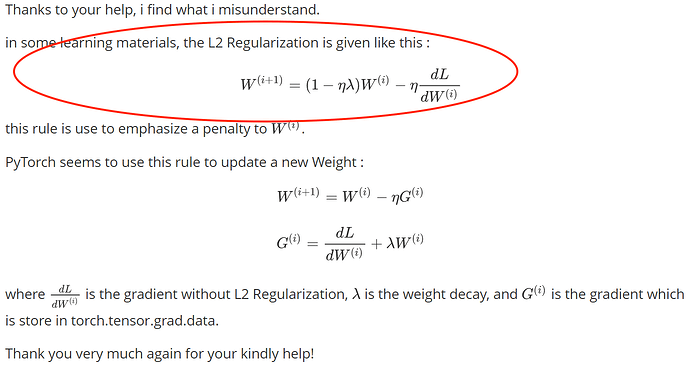Hello,
i write a toy code to check SGD weight_decay.
but it seems to have no effect to the gradient update.
am i misunderstand the meaning of weight_decay?
thank you very much.
PyTorch 1.0
import torch
import numpy as np
np.random.seed(123)
np.set_printoptions(8, suppress=True)
x_numpy = np.random.random((3, 4)).astype(np.double)
w_numpy = np.random.random((4, 5)).astype(np.double)
x_torch = torch.tensor(x_numpy, requires_grad=True)
w_torch = torch.tensor(w_numpy, requires_grad=True)
lr = 0.1
sgd = torch.optim.SGD([w_torch], lr=lr, weight_decay=0.9)
y_torch = torch.matmul(x_torch, w_torch)
loss = y_torch.sum()
print("w_torch before SGD")
print(w_torch.data.numpy())
sgd.zero_grad()
loss.backward()
sgd.step()
w_grad = w_torch.grad.data.numpy()
print("w_torch after SGD")
print(w_torch.data.numpy())
print("check_weight_decay")
print(w_numpy - lr * w_grad)
"""
code output :
w_torch before SGD
[[ 0.43857224 0.0596779 0.39804426 0.73799541 0.18249173]
[ 0.17545176 0.53155137 0.53182759 0.63440096 0.84943179]
[ 0.72445532 0.61102351 0.72244338 0.32295891 0.36178866]
[ 0.22826323 0.29371405 0.63097612 0.09210494 0.43370117]]
w_torch after SGD
[[ 0.20941374 -0.13538012 0.17253327 0.48188881 -0.02361953]
[ 0.04952477 0.37357542 0.37382677 0.46716854 0.6628466 ]
[ 0.50417498 0.40095203 0.50234411 0.13881324 0.17414831]
[ 0.01120012 0.07076036 0.37766885 -0.11270393 0.19814865]]
check_weight_decay
[[ 0.20941374 -0.13538012 0.17253327 0.48188881 -0.02361953]
[ 0.04952477 0.37357542 0.37382677 0.46716854 0.6628466 ]
[ 0.50417498 0.40095203 0.50234411 0.13881324 0.17414831]
[ 0.01120012 0.07076036 0.37766885 -0.11270393 0.19814865]]
"""



 . I will try to explain better. My concern is to know if the weigh_decay functionality is able to distinguish between weighs, bias and learning parameters of batchnorm. Because, Normally weight decay is only applied to the weights and not to the bias and batchnorm parameters (do not make sense to apply a weight decay to the batchnorm parameters). For this reason I am asking if the weigh decay is able to distinguish between this kind of parameters. My feelings after see the code is that weight_decay functionality is not able to distinguis between these parameters, but I would like to have the confirmation.
. I will try to explain better. My concern is to know if the weigh_decay functionality is able to distinguish between weighs, bias and learning parameters of batchnorm. Because, Normally weight decay is only applied to the weights and not to the bias and batchnorm parameters (do not make sense to apply a weight decay to the batchnorm parameters). For this reason I am asking if the weigh decay is able to distinguish between this kind of parameters. My feelings after see the code is that weight_decay functionality is not able to distinguis between these parameters, but I would like to have the confirmation.